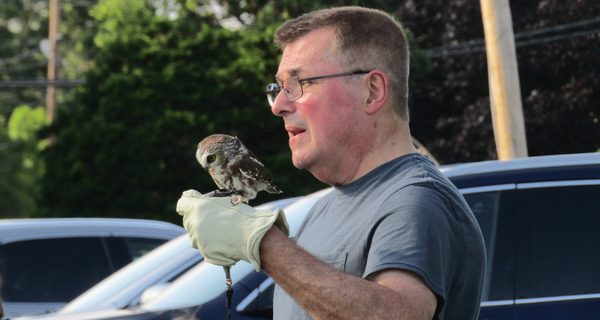By Amelia Tarallo
Hometown Weekly Staff
Have you ever been outside and heard the sound of a hooting owl? Have you spotted the fast flying of a peregrine falcon, or the rusty tail feathers of a red-tailed hawk? If so, you’ve seen some of the birds of prey that call New England home.
On Wednesday, July 28, families visited Memorial Park Gazebo to catch a glimpse of some of these raptors up close.
Jim Parks of Wingmasters handled the birds during the presentation and helped teach the audience all about his feathered friends. Parks began with one of the smallest birds in the bunch. The first bird of the group weighed only six ounces. “She considers herself to be one of the largest birds in the world,” joked Parks. Audience members chuckled as he removed the tiny bird from her carrier. The peregrine falcon kept a careful eye on the audience as Parks brought her around and informed them about her hunting habits, which includes snatching other birds right out of the sky.
The next bird to take the stage was a much larger individual: a red-tailed hawk. Parks informed the audience about the differences between the hawk and the falcon. Unlike the falcon, the red-tailed hawk doesn’t hunt birds in the sky.
This particular red-tailed hawk represented one of the oldest that Parks cares for. Red-tailed hawks typically only live from eight to ten years in the wild. Parks rescued this injured individual twenty years ago. Thanks to a tracking band on his leg, Parks was able to contact the researcher about the bird and discovered his age: today, the hawk is 34 years old with no signs of slowing down.
Before bringing out the next bird, Parks asked his audience why it is so hard to find owls. Kids in the audience raised their hands with answers, coming to the conclusion that camouflage and being nocturnal makes it difficult to see. Lucky for these kids, Parks brought a couple with him.
Parks reminded his audience that the first owl was not a baby; it was just an extremely small owl. The screech owl is a tiny species with tiny tufts on its head. “These aren’t her ears,” Parks told the astonished owl. Instead, their ears are located near their eyelids. “The tufts are just camouflage.” It’s unclear how much kids heard as they gushed over the tiny, adorable owl.
The second owl of the bunch was introduced as the largest owl that can be found in the Needham area. “This is called an opportunist. This is a problem. They do not consider the consequences,” explained Parks. One of these owls was rescued after attacking a porcupine. After it was released, it was rescued again months later. Parks explained that this particular owl is one of the only natural predators of the fisher cat. The owl resting on Park’s hand was perfectly well-behaved, making it hard to imagine this elegant bird attacking something so vicious.
Raptors - most especially owls - are often a bit elusive in the wild. That fact only served to make last Wednesday's up-close Wingmasters experience that much more special for the kids and families who'd gathered by Memorial Park Gazebo.


















